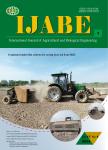Spatiotemporal changes and influencing factors of the intensity of agricultural water footprint in Xinjiang, China
作者机构:Postdoctoral WorkstationChina ReinsuranceBeijing 100032China State Key Laboratory of Water Cycle Simulation and RegulationDepartment of Water ResourcesChina Institute of Water Resources and Hydropower ResearchBeijing 100038China College of Water Conservancy and Architectural EngineeringShihezi UniversityShihezi832003XinjiangChina Aketao County Water Conservancy Bureau of Kizilsu Kirgiz Autonomous PrefectureKizilsu Kirgiz Autonomous Prefecture 845500XinjiangChina Hunan Institute of Water Resources and Hydropower ResearchChangsha 410001China
出 版 物:《International Journal of Agricultural and Biological Engineering》 (国际农业与生物工程学报(英文))
年 卷 期:2023年第16卷第3期
页 面:262-272页
核心收录:
学科分类:120301[管理学-农业经济管理] 12[管理学] 1203[管理学-农林经济管理]
基 金:This work was financially supported by the Third Xinjiang Scientific Expedition(Grant No.2022xjkk0103,2021xjkk0406) the National Natural Science Foundation of China(Grant No.52179028) the Water Conservancy Science and Technology Project of Hunan Province(Grant No.XSKJ2019081-02) the Xinjiang Water Conservancy Science and technology project(Grant No.XSKJ-2021-01)
主 题:agricultural water footprint intensity theil index logarithmic mean divisia index Xinjiang
摘 要:Xinjiang Uygur Autonomous Region,the largest agricultural high-efficiency water-saving arid area in China,was adopted to explore the coupling relationship between agricultural water consumption and economic benefits,which is of great significance to guiding the efficient utilization and sustainable development of agricultural water *** study utilizes an indicator,termed the Agricultural Water Footprint Intensity(short as AWFI,which means the amount of water resource consumed per unit of agricultural GDP),to study the economic benefits of agricultural water in Xinjiang from *** addition,the Theil index,a measure of the imbalance between individuals or regions,was used to study the evolution in the spatial differences in water efficiency,and the Logarithmic Mean Divisia Index(LMDI)method was applied to quantify the factors driving the *** results showed that AWFI in Xinjiang has experienced three stages:obvious decline,stable and slow decline,which decreased from 16114 m^(3)/10^(4) CNY to 2100 m^(3)/10^(4) CNY,decreasing by 86.97%.The Theil index indicated that the spatial evolution of 14 prefectures(cities)resembled an inverted N-shaped Kuznets curve over *** the influencing factors,the contributions of water-saving technology and planting structure to the change in the AWFI in Xinjiang,China from 1991 to 2018 were 154.03%and−37.98%,*** total contribution to AWFI of the total population,urbanization rate,and production scale was−16.06%.This study concluded that further improvements in the economic benefits of agricultural water consumption can be obtained by continuing to promote more efficient or“water-conservationirrigation technologies(engineering aspects),adjusting the planting structure(policy guidance aspects),and intensive management of cultivated land(management aspects).



